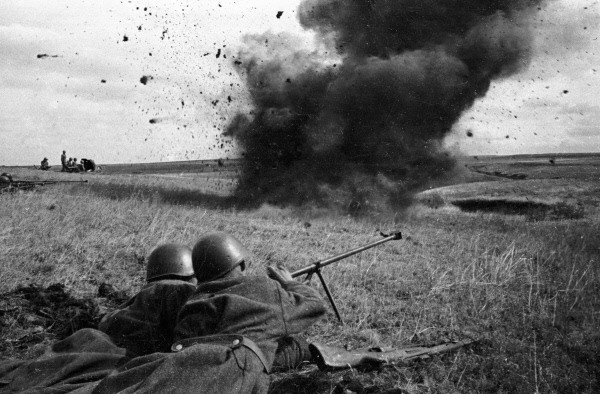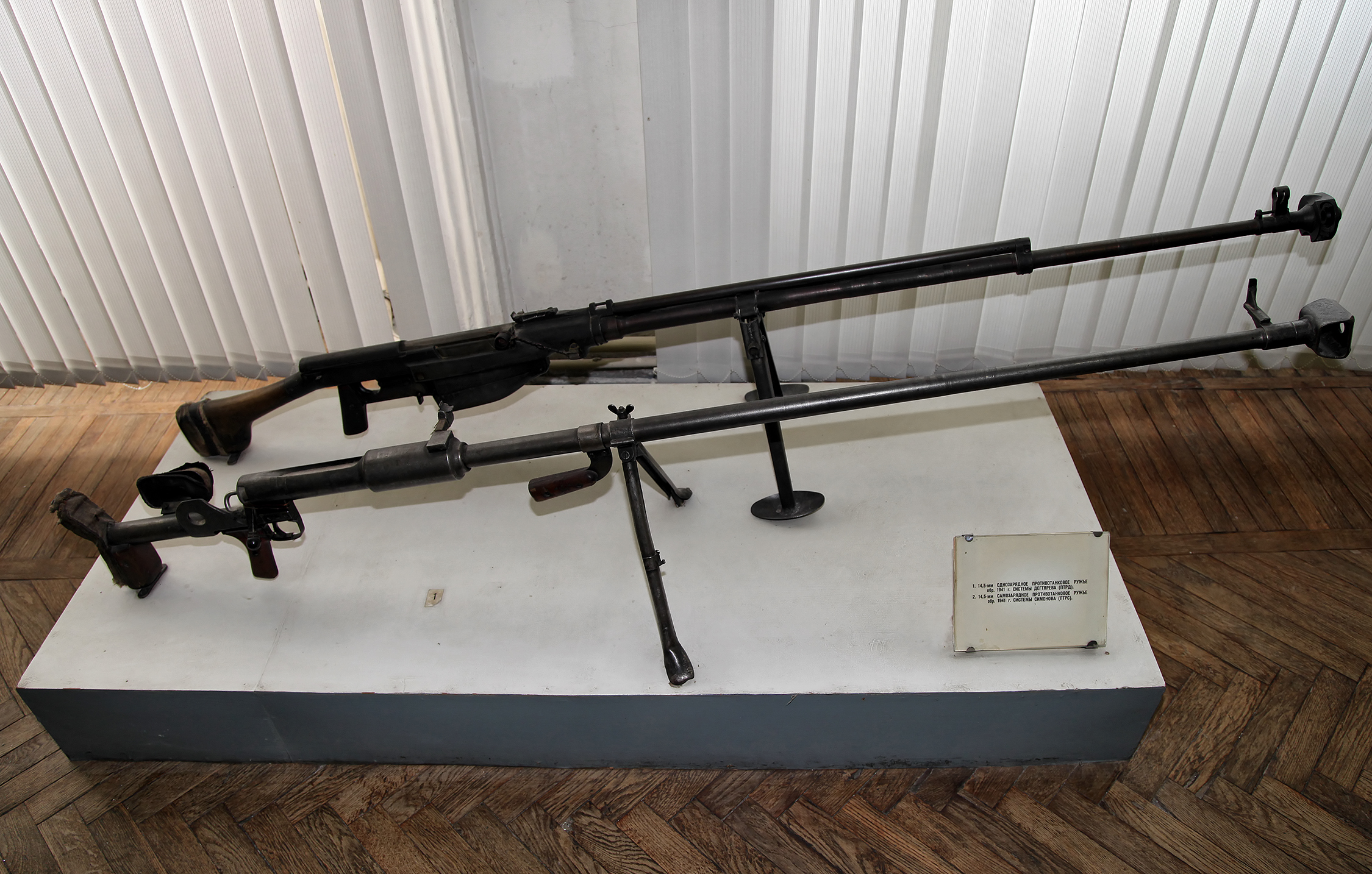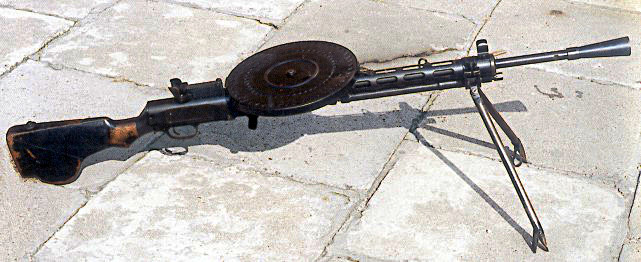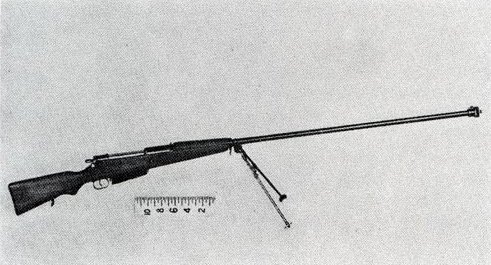|
PTRD-41
The PTRD-41 (Shortened from Russian, ''ProtivoTankovoye Ruzhyo Degtyaryova''; ''–Я—А–Њ—В–Є–≤–Њ—В–∞–љ–Ї–Њ–≤–Њ–µ –Њ–і–љ–Њ–Ј–∞—А—П–і–љ–Њ–µ —А—Г–ґ—М—С —Б–Є—Б—В–µ–Љ—Л –Ф–µ–≥—В—П—А—С–≤–∞ –Њ–±—А–∞–Ј—Ж–∞ 1941 –≥–Њ–і–∞''; "Degtyaryov Single Shot Anti-Tank Weapon System Model of 1941") was an anti-tank rifle produced and used from early 1941 by the Soviet Red Army during World War II. It was a single-shot weapon which fired a 14.5√Ч114 mm round, which was able to penetrate German tanks such as the Panzer III and early models of the Panzer IV. Although unable to penetrate the frontal armor of late-war German tanks, it could penetrate their thinner side armor at close ranges as well as thinly armored self-propelled guns and half-tracks. History In 1939, in its invasion of Poland the USSR captured several hundred Polish Model 35 anti-tank rifles, which had proved effective against the German invasion of Poland from the West. Vasily Degtyaryov copied its lock and several features of the Ge ... [...More Info...] [...Related Items...] OR: [Wikipedia] [Google] [Baidu] |
PTRD-41
The PTRD-41 (Shortened from Russian, ''ProtivoTankovoye Ruzhyo Degtyaryova''; ''–Я—А–Њ—В–Є–≤–Њ—В–∞–љ–Ї–Њ–≤–Њ–µ –Њ–і–љ–Њ–Ј–∞—А—П–і–љ–Њ–µ —А—Г–ґ—М—С —Б–Є—Б—В–µ–Љ—Л –Ф–µ–≥—В—П—А—С–≤–∞ –Њ–±—А–∞–Ј—Ж–∞ 1941 –≥–Њ–і–∞''; "Degtyaryov Single Shot Anti-Tank Weapon System Model of 1941") was an anti-tank rifle produced and used from early 1941 by the Soviet Red Army during World War II. It was a single-shot weapon which fired a 14.5√Ч114 mm round, which was able to penetrate German tanks such as the Panzer III and early models of the Panzer IV. Although unable to penetrate the frontal armor of late-war German tanks, it could penetrate their thinner side armor at close ranges as well as thinly armored self-propelled guns and half-tracks. History In 1939, in its invasion of Poland the USSR captured several hundred Polish Model 35 anti-tank rifles, which had proved effective against the German invasion of Poland from the West. Vasily Degtyaryov copied its lock and several features of the Ge ... [...More Info...] [...Related Items...] OR: [Wikipedia] [Google] [Baidu] |
PTRS-41
The PTRS-41 or Simonov anti-tank rifle (russian: –Я—А–Њ—В–Є–≤–Њ–Ґ–∞–љ–Ї–Њ–≤–Њ–µ –†—Г–ґ—М—С –°–Є–Љ–Њ–љ–Њ–≤–∞) is a World War II-era semi-automatic anti-tank rifle firing the 14.5√Ч114mm cartridge. Design The PTRS-41 was produced and used by the Soviet Union during World War II. In the years between the World Wars, the Soviet Union began experimenting with different types of armour-piercing anti-tank cartridges. Finding the 12.7√Ч108mm insufficient, they began development of what became the 14.5√Ч114mm armour-piercing round. Rukavishnikov developed to use this cartridge, but it was not successful because of some manufacturing issues, a sufficient number of more effective anti-tank guns in the Red Army, and high expectations about new German tank armour. In 1941, the loss of huge amounts of anti-tank artillery created a need for a stop-gap anti-tank weapon, so famous USSR weapons designers such as Vasily Degtyaryov and Sergei Gavrilovich Simonov were tasked to design anti-tank r ... [...More Info...] [...Related Items...] OR: [Wikipedia] [Google] [Baidu] |
Degtyaryov Plant
Degtyaryov Plant (russian: –Ю–Р–Ю –Ч–∞–≤–Њ–і –Є–Љ–µ–љ–Є –Т. –Р. –Ф–µ–≥—В—П—А—С–≤–∞, –Ю–Р–Ю Zavod imeni V. –Р. D–µgtyaryov–∞, English: Open Joint Stock Company " V. A. Degtyaryov Plant") or ZiD (Zavod imeni D–µgtyaryov–∞) is one of the most important weapon and vehicle producing enterprises of Russia. Degtyaryov Plant is a subsidiary of High Precision Systems ( Rostec). History Founded in Kovrov in 1916, the firearms plant has been supplying Russian and Soviet armed forces with weapons ever since. Weapons such as the Degtyaryov anti-tank rifle (PTRD-41), the Degtyaryov machine gun, the Shpagin submachine gun ( PPSh-41) and the Goryunov heavy machine gun (SG-43 Goryunov) were created at the plant. In 1989 it was the fourth largest motorcycle producer in the Soviet Union. Production Presently the Degtyaryov Plant is producing revolvers, machine guns, aircraft guns, anti-aircraft guns, anti-tank guns and rocket systems. Products * KSVK 12.7 sniper rifle *PTRD-41 *KPV heavy ... [...More Info...] [...Related Items...] OR: [Wikipedia] [Google] [Baidu] |
Anti-tank Rifle, Model 35
The Model 35 antitank rifle (''Karabin przeciwpancerny wz√≥r 35'', abbreviated "''kb ppanc wz. 35''") was a Polish 7.9 mm anti-tank rifle used by the Polish Army during the 1939 Invasion of Poland. It was designated model 35 for its design year, 1935: It was also known by its codename "Uruguay", after the country (''kb Urugwaj''; or ''kb Ur'') and by the name of its designer, J√≥zef Maroszek( pl). Secrecy The weapon was initially a top secret project of the Polish Army, and was also known by various codenames. Until mobilization in 1939, the combat-ready rifles were held in closed crates marked: "Do not open! Surveillance equipment!". Another of the rifle's cover names was "Uruguay" (Polish: ''Urugwaj'', hence ''Ur''), the country to which the "surveillance equipment" was supposedly being exported. After the fall of Poland, the German army captured large numbers of the ''kb ppanc wz.35'' and renamed it "''Panzerb√Љchse 35 (polnisch)''" (abbreviated "''PzB 35(p)''"). T ... [...More Info...] [...Related Items...] OR: [Wikipedia] [Google] [Baidu] |
Vasily Degtyaryov
Vasily Alekseyevich Degtyaryov (russian: –Т–∞—Б–ЄћБ–ї–Є–є –Р–ї–µ–Ї—Б–µћБ–µ–≤–Є—З –Ф–µ–≥—В—П—А—С–≤; 2 January 1880, Tula вАУ 16 January 1949, Moscow) was a Soviet and Russian engineer who specialized in weapons design. He was awarded the title of Hero of Socialist Labour in 1940. Biography He was a factory worker at the Tula Arms Plant.–Ф–µ–≥—В—П—А—С–≤ –Т–∞—Б–Є–ї–Є–є –Р–ї–µ–Ї—Б–µ–µ–≤–Є—З // –С–Њ–ї—М—И–∞—П –†–Њ—Б—Б–Є–є—Б–Ї–∞—П –≠–љ—Ж–Є–Ї–ї–Њ–њ–µ–і–Є—П / —А–µ–і–Ї–Њ–ї–ї., –≥–ї. —А–µ–і. –Ѓ. –°. –Ю—Б–Є–њ–Њ–≤. —В–Њ–Љ 8. –Ь., –љ–∞—Г—З–љ–Њ–µ –Є–Ј–і–∞—В–µ–ї—М—Б—В–≤–Њ "–С–Њ–ї—М—И–∞—П –†–Њ—Б—Б–Є–є—Б–Ї–∞—П –≠–љ—Ж–Є–Ї–ї–Њ–њ–µ–і–Є—П", 2007. He became married in 1905. Starting in 1918, Vasily Degtyaryov headed the first Soviet firearms design bureau at Kovrov Arms Factory. In 1927, the Red Army was equipped with his 7.62 mm light machine gun DP-27. This design led to the development of the DT tank machine gun (1927) and two aircraft machine guns: DA and DA-2 (1928). In 1940 he became a ... [...More Info...] [...Related Items...] OR: [Wikipedia] [Google] [Baidu] |
Anti-tank Rifle
An anti-tank rifle is an anti-materiel rifle designed to penetrate the vehicle armor, armor of armored fighting vehicles, most commonly tanks, armored personnel carriers, and infantry fighting vehicles. The term is usually used for weapons that can be carried and used by one person, but is sometimes used for larger weapons. The usefulness of rifles for this purpose ran from the introduction of tanks in World War I until the Korean War. While medium and heavy tank armor became too thick to be penetrated by rigid projectiles from rifles that could be carried by a single soldier, anti-tank rifles continued to be used against other "soft" targets, though recoilless rifles and rocket-propelled grenades such as the bazooka were also introduced for infantry close-layer defense against tanks. History The tug of war between armour and projectiles had been developing for a long while among naval vessels, since the advent of the Ironclad warship, Ironclad. It wasn't until soldiers met armo ... [...More Info...] [...Related Items...] OR: [Wikipedia] [Google] [Baidu] |
Anti-tank Rifle
An anti-tank rifle is an anti-materiel rifle designed to penetrate the vehicle armor, armor of armored fighting vehicles, most commonly tanks, armored personnel carriers, and infantry fighting vehicles. The term is usually used for weapons that can be carried and used by one person, but is sometimes used for larger weapons. The usefulness of rifles for this purpose ran from the introduction of tanks in World War I until the Korean War. While medium and heavy tank armor became too thick to be penetrated by rigid projectiles from rifles that could be carried by a single soldier, anti-tank rifles continued to be used against other "soft" targets, though recoilless rifles and rocket-propelled grenades such as the bazooka were also introduced for infantry close-layer defense against tanks. History The tug of war between armour and projectiles had been developing for a long while among naval vessels, since the advent of the Ironclad warship, Ironclad. It wasn't until soldiers met armo ... [...More Info...] [...Related Items...] OR: [Wikipedia] [Google] [Baidu] |
Soviet Union
The Soviet Union,. officially the Union of Soviet Socialist Republics. (USSR),. was a transcontinental country that spanned much of Eurasia from 1922 to 1991. A flagship communist state, it was nominally a federal union of fifteen national republics; in practice, both its government and its economy were highly centralized until its final years. It was a one-party state governed by the Communist Party of the Soviet Union, with the city of Moscow serving as its capital as well as that of its largest and most populous republic: the Russian SFSR. Other major cities included Leningrad (Russian SFSR), Kiev (Ukrainian SSR), Minsk ( Byelorussian SSR), Tashkent (Uzbek SSR), Alma-Ata (Kazakh SSR), and Novosibirsk (Russian SFSR). It was the largest country in the world, covering over and spanning eleven time zones. The country's roots lay in the October Revolution of 1917, when the Bolsheviks, under the leadership of Vladimir Lenin, overthrew the Russian Provisional Government ... [...More Info...] [...Related Items...] OR: [Wikipedia] [Google] [Baidu] |
Semi-automatic Firearm
A semi-automatic firearm, also called a self-loading or autoloading firearm (fully automatic and selective fire firearms are also variations on self-loading firearms), is a repeating firearm whose action mechanism ''automatically'' loads a following round of cartridge into the chamber (self-loading) and prepares it for subsequent firing, but requires the shooter to ''manually'' actuate the trigger in order to discharge each shot. Typically, this involves the weapon's action utilizing the excess energy released during the preceding shot (in the form of recoil or high-pressure gas expanding within the bore) to unlock and move the bolt, extracting and ejecting the spent cartridge case from the chamber, re-cocking the firing mechanism, and loading a new cartridge into the firing chamber, all without input from the user. To fire again, however, the user must actively release the trigger, allow it to "reset", before pulling the trigger again to fire off the next round. As a result, eac ... [...More Info...] [...Related Items...] OR: [Wikipedia] [Google] [Baidu] |
Anti-tank
Anti-tank warfare originated from the need to develop technology and tactics to destroy tanks during World War I. Since the Triple Entente deployed the first tanks in 1916, the German Empire developed the first anti-tank weapons. The first developed anti-tank weapon was a scaled-up bolt-action rifle, the Mauser 1918 T-Gewehr, that fired a 13mm cartridge with a solid bullet that could penetrate the thin armor of tanks of the time and destroy the engine or ricochet inside, killing occupants. Because tanks represent an enemy's strong force projection on land, military strategists have incorporated anti-tank warfare into the doctrine of nearly every combat service since. The most predominant anti-tank weapons at the start of World War II in 1939 included the tank-mounted gun, anti-tank guns and anti-tank grenades used by the infantry, and ground-attack aircraft. Anti-tank warfare evolved rapidly during World War II, leading to the inclusion of infantry-portable weapons such a ... [...More Info...] [...Related Items...] OR: [Wikipedia] [Google] [Baidu] |
Panzer I
The Panzer I was a light tank produced in Nazi Germany in the 1930s. Its name is short for (German for "armored fighting vehicle mark I"), abbreviated as . The tank's official German ordnance inventory designation was ''Sd.Kfz. 101'' ("special purpose vehicle 101"). Design of the Panzer I began in 1932 and mass production began in 1934. Intended only as a training tank to introduce the concept of armored warfare to the German Army, the Panzer I saw combat in Spain during the Spanish Civil War, in Poland, France, the Soviet Union and North Africa during the Second World War, and in China during the Second Sino-Japanese War. Experiences with the Panzer I during the Spanish Civil War helped shape the German Panzerwaffe's invasion of Poland in 1939 and France in 1940. By 1941, the Panzer I chassis design was used as the basis of tank destroyers and assault guns. There were attempts to upgrade the Panzer I throughout its service history, including ... [...More Info...] [...Related Items...] OR: [Wikipedia] [Google] [Baidu] |



_Streets.jpg)





